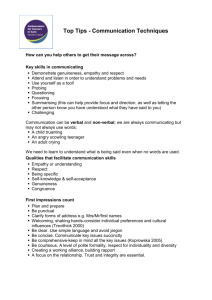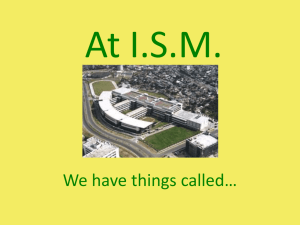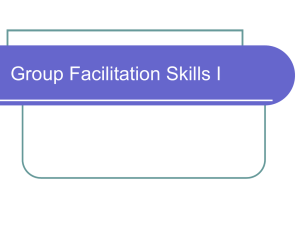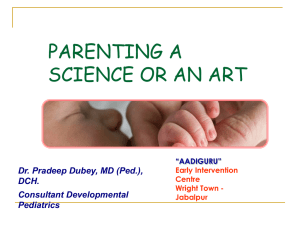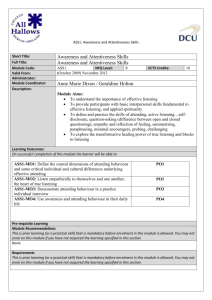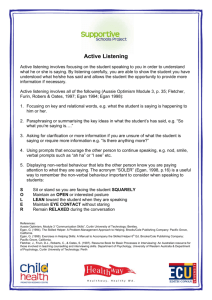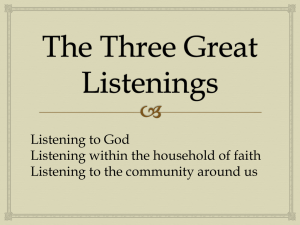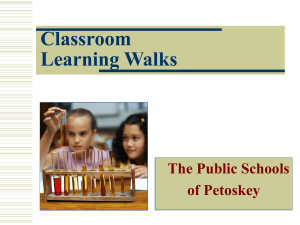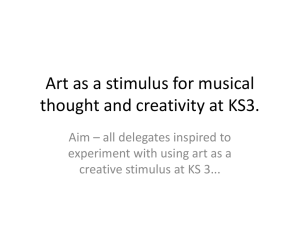Building_Great_Customer_Service_MW!_Aaron_Leson
advertisement
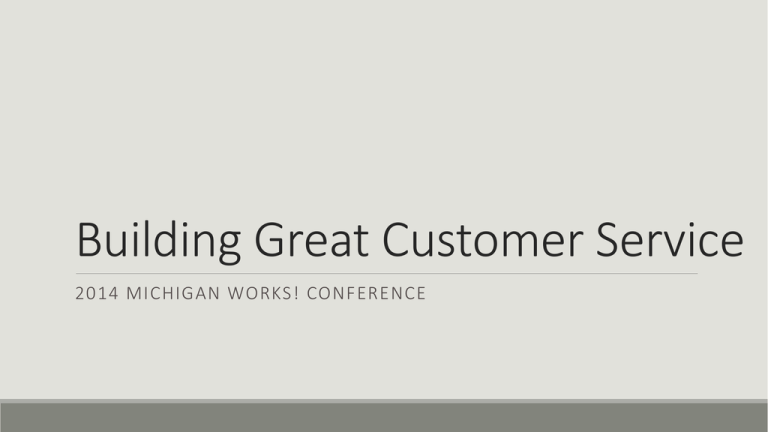
Building Great Customer Service 2014 MICHIGAN WORKS! CONFERENCE Purpose of this Presentation Review the basic tenets of providing good customer service Discuss the two types of customers Examine the traits of healthy helping relationships Reveal what customers really need 10 action steps “A customer is the most important visitor on our premises. He is not dependent on us. We are dependent on him. He is not an interruption in our work. He is the purpose of it. He is not an outsider in our business. He is part of it. We are not doing him a favor by serving him. He is doing us a favor by giving us an opportunity to do so.” Activity Customer Service Defined At your seats, please answer the following questions: What is Customer Service? What are the two types of customers? With someone seated next to you, take a minute and share a personal story regarding the best or worst customer service you have experienced. Self Assessment 1 = Underutilized 2 = Satisfactory 3 = Very Good 1. Greeting customers with a smile 2. Being helpful, even if there is no profit in it (above and beyond?) 3. Knowing your product or service (other programs?) 4. Listening to customers (content and feeling) 5. Making customers feel important and appreciated 6. Making things (services/processes) easy for customers 7. Throwing in something extra (what was/is it?) 8. Saying thank-you N/A=Not Applicable Ingredients of a Helping Relationship Acceptance Warmth Respect Healthy Relationships Empathy Trust Understanding Ingredients Defined Acceptance is the act of relating to another person without judging him or her. Respect is an attitude of giving dignity to each individual. We practice empathy when we put ourselves in our clients’ shoes and try to experience their lives as they experience them. We feel and experience understanding when we believe that another person has listened to us carefully and thoughtfully enough to relate to our experience. Trust is a feeling that individuals experience when they believe that they are safe. Warmth? “An authentic sincerity.” Egan, G. (2009). The skilled helper: A problem management and opportunity development approach to helping (9th ed.). Belmont, CA: Brooks Cole. Customer Service Skills Attentiveness Reflection Active Listening Clear Patience & Communication Professionalism Attentiveness Being attentive involves a sustained, committed effort to hear – truly hear – what another person is saying, going beyond listening to the content of the message. Within a helping relationship, attentiveness is communicated largely by how we orient ourselves physically toward the client (Egan, 2009). S: Squarely O: Open L: Lean E: Eye Contact R: Relaxed Reflection Providing good customer service requires individuals to serve as a mirror, reflecting back both the content and feeling of their client’s messages. 1. Since the car accident, I seem to have lost a lot of my self-confidence, and that makes starting all over again even more frightening! Reflection: You feel………….. 2. I don’t have time to read all this stuff – just give me your summary of it! Reflection: You feel………….. 3. With three kids to take care of, there’s no way that I can consider going back to school to get some new job skills. Reflection: You feel………….. Active Listening Listening is much more complex than just hearing what is being said. It involves paying attention to both content and feeling. It requires engagement and confirmation. Clear Communication Clear communication is essential to customer service – you need to know what the customer wants and possess the ability to articulate what you can do for them. Enunciation, speaking loudly enough, and employing an upbeat/positive tone are essential. When writing or emailing customers, be sure to use proper grammar and spelling, and choose words and phrases that convey an upbeat attitude. Clear communication skills are essential in phone communication as well. Telephone Etiquette Tips 1. Answer promptly (on the third ring at the latest). 2. Before you pick up the phone, end any other conversation you’re having. 3. Greet the caller, identify yourself, and ask if you can help (standardized). 4. Speak clearly and in a pleasant tone of voice (avoid speaking too quickly). 5. Be patient and accommodating. 6. When you put someone on hold, ask permission first. 7. When you end a call, let the customer hang up first—this will ensure that you don’t cut the customer off prematurely. Professional Appearance “THE PROFESSIONAL IMAGE OF WORKERS MAY BE WEAKENED IF CLIENTS FEEL EMPLOYEES ARE TOO CASUAL TO BE ENTRUSTED WITH THEIR BUSINESS” (GUTIERREZ & FREESE, 1999). “THE WAY YOU LOOK DIRECTLY AFFECTS THE WAY YOU THINK, FEEL, AND ACT” (KAPLANLEISERSON, 2000). Professional Workspace A NEW SURVEY BY RETAILER OFFICEMAX FINDS THAT 90% OF AMERICANS BELIEVE CLUTTER HAS A NEGATIVE IMPACT ON THEIR LIVES AND WORK. “YOUR PERFORMANCE COINCIDES WITH YOUR WORKSPACE. WHEN IT’S ORGANIZED AND PRECISE, YOU HAVE THE MINDSET AND MOTIVATION TO WORK” (DEDE, 2012). Professional Internal Customer Service WHO IS AN INTERNAL CUSTOMER? DEVELOPING OUTSTANDING INTERNAL CUSTOMER SERVICE Internal customers are our co-workers, Acknowledge teammates with a our immediate supervisors, and our smile and a greeting partners-- all of the contractors and administrators within the organization. Get to know your teammates Get the “big picture” Always close the loop Make your co-workers feel valued Identify and anticipate needs “There's a remarkably close and consistent link between how internal customers are treated and how external customers perceive the quality of your organization's services. A commitment to serve internal customers invariably shows itself to external customers. It's almost impossible to provide good external service if your organization is not providing good internal service." – Benjamin Schneider, University of Maryland What Customers Need Providing Unbelievable Customer Service Friendliness Friendliness is the most basic of all customer needs, usually associated with being greeted graciously and with a smile. We all want to be acknowledged and welcomed by someone who is glad to see us. A customer should never feel that they are an intrusion on your work day. Question: How do you ensure friendliness is conveyed? Understanding and Empathy Customers need to feel that you understand and appreciate their circumstances without criticism or judgment. Question: What can be taken from the message above? Fairness We all need to feel we are being treated fairly. Customers may get annoyed and defensive when they feel they are subject to unfair treatment. Question: What characteristics/actions can we display to relay the message of fairness? Does it always work? Control Control represents the customers' need to feel they have an impact on the way things turn out. Question: How can you empower customers to take control of their situation? Options and Alternatives Customers need to feel that other avenues are available to getting what they want accomplished. They realize that they may be in uncharted waters, and they depend on us to be "in the know". Question: What is your scope of practice and do you have a referral resource network? Information Customers need to be educated and informed about our products and services, and they don't want us to leave anything out! + Question: Who are your partners, what are their programs, and do you know all of the resources available within your office (not just your program or department)? Ten Tips Greet customers with a smile Be helpful Know your product or service Don’t make customers feel inadequate Listen to your customers Employees will treat customers the way they are treated by management Feel important and appreciated Make things easy Throw in something extra Say Thank You Questions? Contact Information Aaron Leson (269) 967-5460 aleson@michiganworks14.org www.linkedin.com/pub/aaronleson/5/ba1/152/

